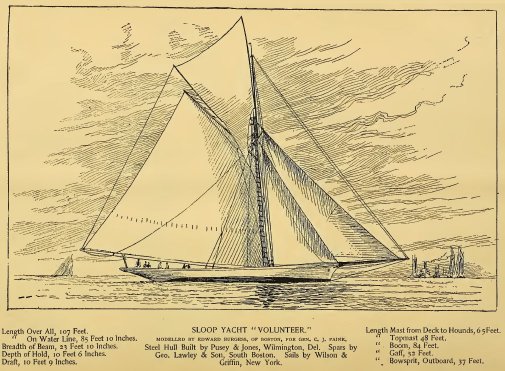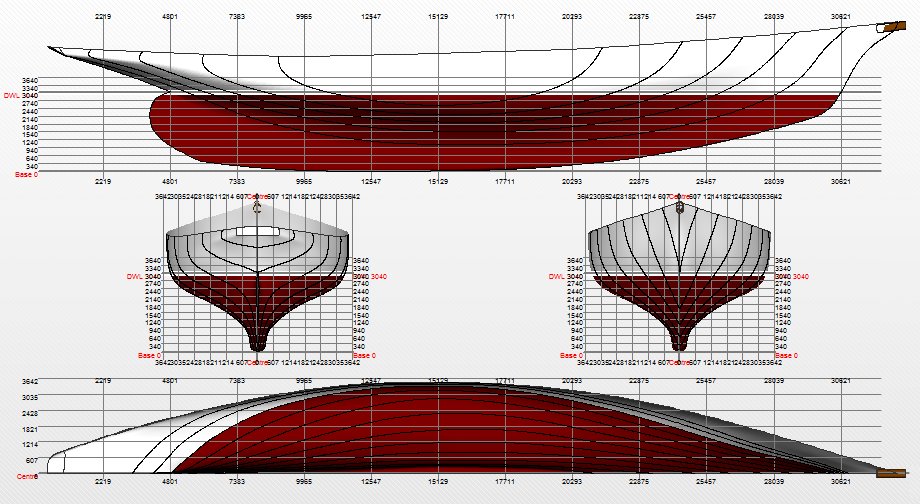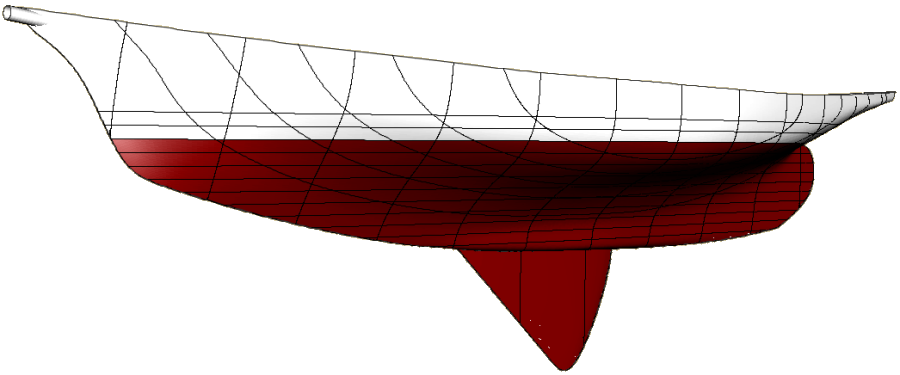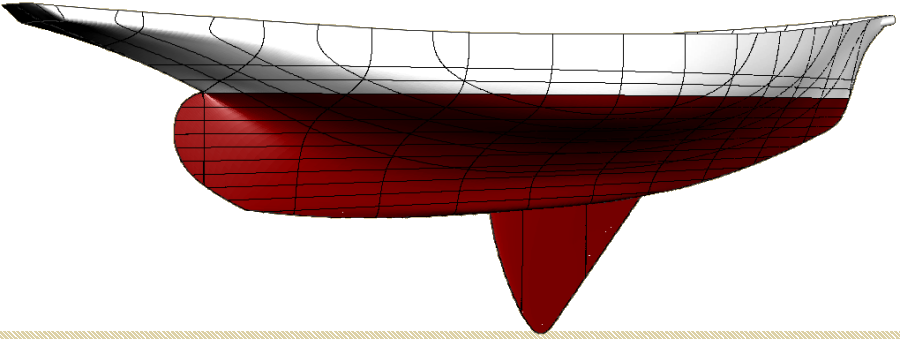Yves GARY Hits: 8771
Category: VOLUNTEER
 When the measurements of the Thistle became known, in the spring of 1887, Mr. Burgess immediately began work on the designs of a steel centre-board sloop of about the same water-line length as the Thistle, and General Paine immediately stepped to the front in defense of the Cup, and bore the entire expense of building and fitting out a yacht from the new designs.
When the measurements of the Thistle became known, in the spring of 1887, Mr. Burgess immediately began work on the designs of a steel centre-board sloop of about the same water-line length as the Thistle, and General Paine immediately stepped to the front in defense of the Cup, and bore the entire expense of building and fitting out a yacht from the new designs.
The result was the Volunteer, the fastest sloop in the world. The builders were Messrs. Pusey & Jones, of Wilmington. The Thistle was then nearly ready to be launched and put in proper trim, and it was necessary that speedy work should be done to build the Volunteer in time to give her a thorough trial before her contest for the America's Cup. In consequence of the limited time, the plating of the steel hull was not as smooth as it would otherwise have been.
 The Volunteer's ballast is stowed two feet lower than the oak keels will allow in the Puritan and Mayflower, and this gives her greater stability than the two latter boats possess. The frames arc of steel, spaced twenty-one inches on centres, and along the centre-board well there are twenty-two angle-iron frames. The well is plated with steel. The outside plating is steel, and is flushed from keel to gunwale. The keel-plating, three-fourths of an inch in thickness, is riveted to transverse frames. In the trough in which the ballast is stowed there is a steel floor- plate at each frame, and in these spaces molten lead was run, thus making solid ballast. The deck-beams are made of angle iron, 3x4xY^g inches thick. To counteract the strain of the mast, the frames along the sides, opposite the mast, are strengthened by steel brackets riveted to the frames and deck beams. At the turn of the bilge, and between the cabin floor and keel, the hull is stiffened by two thick steel strakes.
The Volunteer's ballast is stowed two feet lower than the oak keels will allow in the Puritan and Mayflower, and this gives her greater stability than the two latter boats possess. The frames arc of steel, spaced twenty-one inches on centres, and along the centre-board well there are twenty-two angle-iron frames. The well is plated with steel. The outside plating is steel, and is flushed from keel to gunwale. The keel-plating, three-fourths of an inch in thickness, is riveted to transverse frames. In the trough in which the ballast is stowed there is a steel floor- plate at each frame, and in these spaces molten lead was run, thus making solid ballast. The deck-beams are made of angle iron, 3x4xY^g inches thick. To counteract the strain of the mast, the frames along the sides, opposite the mast, are strengthened by steel brackets riveted to the frames and deck beams. At the turn of the bilge, and between the cabin floor and keel, the hull is stiffened by two thick steel strakes.
The plank sheer is of white pine. The waist has locust stanchions and the rail is of oak. Her deck is flush and of white pine. Her bow, unlike the Cup defenders of 1885 and 1886, is an overhanging one, but the stern differs very slightly. Compared with the Mayflower she has less beam and more bilge. Her greatest vantage point over the Mayflower, however, is in her lower centre of gravity. Her chain-plates run along the frames on the inside of the plating, thus leaving her sides clean. The bowsprit is a reefing one, the first to be put on a Burgess sloop of the first class,  and it can be shortened eight feet. Steel wire is used for the main rigging, and above, as well as below decks, the strongest and best materials were employed in her construction.
and it can be shortened eight feet. Steel wire is used for the main rigging, and above, as well as below decks, the strongest and best materials were employed in her construction.
On each side of the centre-board box there is a passage, and leading out of each there are two state-rooms, which are conveniently fitted up and neatly furnished. The main saloon contains two berths on each side, and aft there is a good-sized stateroom. The quarters of the crew are roomy, light, and well ventilated. There is ample room, and, while it was sought to attain speed, it should not be inferred that the Volunteer is a mere racing-machine.
Minor changes only were made in her during the season, and her measurements at the time of the Cup races were as follows:
Length over all, 106.23 feet; length on water-line, 85.88 feet; beam, 23 feet 2 inches; draught, 10 feet; length of mast from deck to hounds, 03 feet; length of topmast, 48 feet; length of boom, 84 feet; length of gaff, 51 feet 6 inches; length of bowsprit, outboard, 38 feet; length of spinnaker-boom, 67 feet ; displacement, 130 tons ; ballast, inside and keel, 55 tons; sail area (New York Yacht Club rules), 9,260 square feet; racing measurement (New York Yacht Club rules), 89.35.
|
|
|||||||||||||||||||||||||||||||||||||||||||||||||||
Plan created with DELFTSHIP

Download the MODEL FOR DELFTSHIP : Hull only
Download the MODEL FOR DELFTSHIP : Full model


